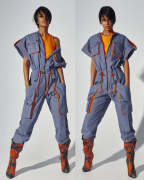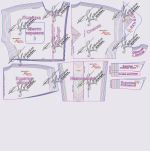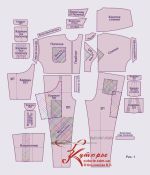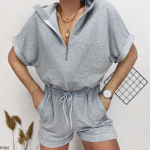Size charts What is the height of the pattern Payment methods Ask a question Reviews
Electronic pattern of an oversized jumpsuit for printing in full size on all sizes from 40 to 54 from one PDF file.
 Free download instructions on how to sew this jumpsuit pattern
Free download instructions on how to sew this jumpsuit pattern
Instructions for simple patterns of women's kimono overalls with large pockets - how to sew with your own hands at home
- Description of patterns.
- Complete set of patterns of overalls.
- Description of the design and what to sew for spring and summer.
- How to buy and print patterns.
- How to cut a jumpsuit with a short one-piece sleeve.
- How to sew a women's jumpsuit for spring and summer.
 Buy and download this oversized jumpsuit pattern
Buy and download this oversized jumpsuit pattern
1. Description of patterns
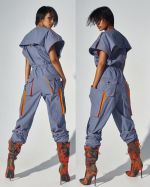 In one pattern pattern file for all overall sizes from 40 to 54.
In one pattern pattern file for all overall sizes from 40 to 54.
File format: PDF full size and without seam allowances
After paying for the order, you will receive links to download two files women's kimono jumpsuit with big pockets:
- PDF file A4, adapted for printing patterns on sheets of A4 paper in any program on any device, including mobile phones.
- Multi-format PDF file for printing on sheets of any size from A0 to A4 on a printer or plotter using Adobe Reader.
The level of complexity of sewing is medium - the couturier will need confident cutting and sewing skills.
The style is suitable for slim and tall girls or young women. Pocket patterns can be used in other military or casual items.
The pattern is designed for sewing at home on household sewing machines.
In addition to a universal sewing machine, you will need an overlocker or a binder for processing open sections.
2. Complete set of overalls patterns
- Bodice patterns: Back and Shelf, Back yoke, Pick-up and Facing of the sprout, as well as Facing for processing the back opening.
- Trouser pattern: PP (Front half) and ZP (Back half).
- Pattern of the largest pocket - Pocket PP - ZP.
- Knee pad.
- Front pocket: a pocket pattern with an inverse pleat, a congruent pocket pattern without a pleat (template) and a flap pattern for this pocket.
- Small pocket on the right PP: a pocket and a flap for it.
- ZP pocket: pattern of a pocket with two folds, pattern of a congruent pocket without folds (template) and a flap to it.
- Kimono sleeve facings for front and back.
- Straps: on the PP, under the knee and shoulder straps.
- Collars: turn-down and stand-up collar (they are not in the photo, but can be used when sewing).
The pattern for the drawstring at the waist is not included, as it is a rectangular strip of fabric.
Patterns of finishing details are also not included in the kit, as these are also strips of fabric.
How to cut these details read below in the instructions.
3. Description of the design and what to sew for spring and summer
3.1. Description of the style of summer kimono overalls
 The number of pockets and tabs distracts us from the laconic cut of this kimono short-sleeve jumpsuit with tapered trousers, cut off at the waist.
The number of pockets and tabs distracts us from the laconic cut of this kimono short-sleeve jumpsuit with tapered trousers, cut off at the waist.
Large volume, large pockets - a "classic" oversize on the border of casual and military.
Pleated book pockets, tabs and piping do a great job of romanticizing this jumpsuit, taking it beyond just casual wear.
The model claims to be the favorite of the modern fashionista, who accepts difficult life challenges.
3.2. From what to sew a jumpsuit with a kimono sleeve and pockets, how much fabric is needed
Choose from thin, but dense, stable fabrics (without signs of elasticity).
Suitable for both thin denim and thick shirt chintz or cotton satin.
The above fabrics may have a small addition of synthetic fibers - this will protect the finished product from shrinkage and increase its wear resistance.
The consumption of the main fabric will be from 240 to 300 cm, and the finishing one - 30 - 50 cm. This is with a width of 150 cm.
4. How to buy and print patterns
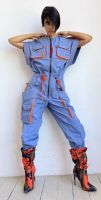 How to choose a size without using tables and taking measurements
How to choose a size without using tables and taking measurements
What height are the patterns for?
How to buy a ready-made electronic pattern
How to print a pattern at home in full size on A4 sheets or on sheets of any other size
How to assemble a pattern after printing
Simple patterns for dresses, sweatshirts, skirts and trousers in full size Free
Buy and download this oversized jumpsuit pattern
5. How to cut a jumpsuit with a short one-piece sleeve
In general, cutting is quite simple - on a fabric folded in half, the patterns are laid out in the most economical way, taking into account the shared direction (picture 2).
When laying out, keep in mind that pocket patterns for a shelf without folds and for trousers without folds are used only as templates for precise marking on cut details and for ironing blanks.
Seam allowances - 1 - 1,2 cm. Exceptions - the bottom of the trousers (2,5 - 3 cm), the bottom of the backrest (2 - 4 cm), the sections of the entrance to the pockets (2,5 cm), the upper sections of the valves - 1,5 - 2 cm. Without allowances - concave sections - neck, sprout, entrance to the largest pocket.
A separate explanation requires cutting straps. As shown in 2 drawing, the strap is traced twice, the outlines of the stroke are in contact along the long side and enclosed in a allowance rectangle.
 In addition to the straps, the “lower” parts of the valves, facings for the bodice, the selection and hem of the entrance to the pocket should be duplicated. At the same time, dubbing details are cut out without seam allowances.
In addition to the straps, the “lower” parts of the valves, facings for the bodice, the selection and hem of the entrance to the pocket should be duplicated. At the same time, dubbing details are cut out without seam allowances.
Cutting the subbelt and finishing strips
Sub-belt for processing the drawstring, as mentioned above, a strip of fabric.
The length of the subbelt in the cut = the length of the drawstring (measured by the product) + 2 cm
The width of the subbelt in the cut = the width of the drawstring 3 cm + 2 cm.
Finishing strips should be 4-5 cm wide in cutting. They should be cut along an oblique thread, as for an oblique inlay. Oblique stripes will make it easier to process pockets.
After cutting, mark the details of the cut, as shown in the drawing.
6. How to sew a women's jumpsuit for spring and summer
- We start with processing the folds on the pockets and processing the valves and straps.
- We process the entrances to the pocket and iron the pockets on the templates, as regular patch pockets
- We make an oblique trim from a finishing fabric for processing pockets. The optimal width of such an inlay in finished form will be 2 - 2,5 cm.
- We grind the inlay along the edge of the ironed pocket blanks.
- We adjust pockets for details - for shelves, for the largest pocket, for RFP.
- We process the middle seam of the back and the hole on it.
- We process the bottom of the yoke into a hem with a closed cut (double hem) and connect it to the back.
- We process the shoulder seams of the bodice, fasten the straps under the knee to the RFP and grind the side seams of the trousers.
- We fasten the remaining straps - shoulder strap and strap on the PP.
- Then, we duplicate what else needs to be duplicated - the selection and turning.
- We iron the detachable cut of the facings along the sleeve of the kimono and process the bottom of the sleeves.
- We set up a large pocket.
- We grind the side seams of the bodice, the crotch seams of the trousers, the shoulder seams of the hem and the facing of the sprout.
- Let's do an example. When trying on, it is important to find the optimal position of the waist of the bodice.
To do this, we put on the bodice and tie it with a linen elastic band, form an overlap.
After that, you can connect the bodice with trousers and baste the zipper.
Sit down, make sure the overalls don't get too tight when you sit down.
For ease of wearing, you can lower the seat line and the waist line of the bodice. - After trying on, you should connect the bodice with trousers.
- Stitch the zipper and overstitch the neckline and sides of the bodice.
- Finally, the holes for the drawstring are processed, the strip under the belt is ironed and adjusted from the inside or outside of the overalls.
- And the bottom of the trousers remains, which should be processed into a hem with a closed cut (double hem).
Download this pattern pdf:
Patterns of women's kimono overalls with large pockets
$2.00 (80 hryvnia)
Bank cards of the Russian Federation are not accepted for payment!
Size charts What is the height of the pattern Payment methods Ask a question Reviews
Vera Olkhovskaya in social networks:

See similar clothing patterns and how to sew on them
-
Any pattern for free for a review of a previously made order
More...
Lifetime promotion for buyers of patterns!

Leave a review about my store of patterns for an order that you made before, and you will receive any paid pattern of your choice Free!
